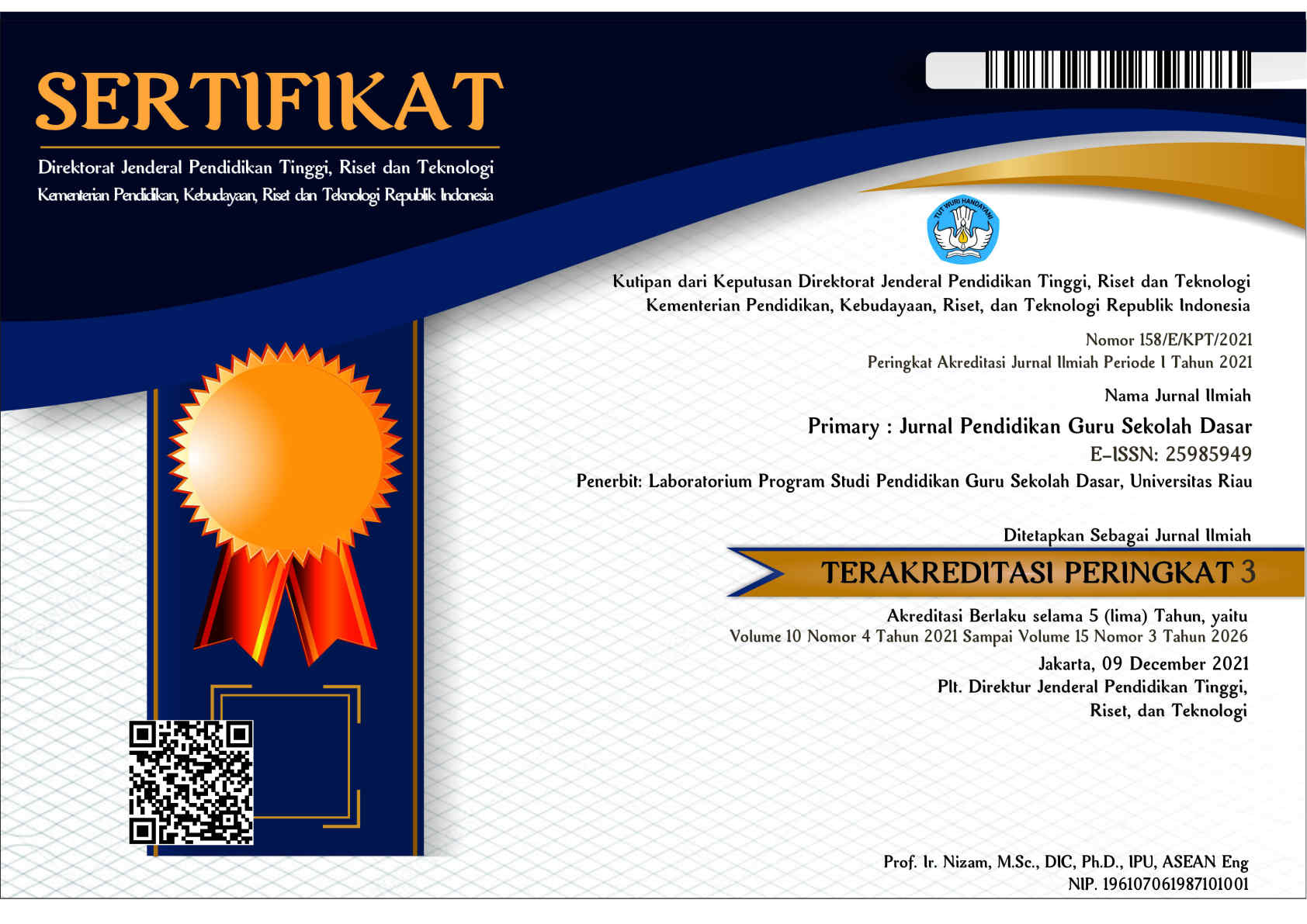Improving the Fifth-Grade Elementary Students’ Learning Activity, Learning Outcome, Motivation, and Critical Thinking Skills Using the PROSOTAN HORAY Model
Abstract
The research problem in this paper comes from students' low activity, motivation, critical thinking skills, and learning outcomes. This paper describes the improvement of learning quality through educator activities, students’ learning outcomes, students’ learning activity analysis, motivation, and students’ critical thinking skills. The research uses Classroom Action Research (PTK), which was conducted in 4 meetings. The research subjects were 23 fifth-grade elementary students. The types of research data were qualitative and quantitative data. Qualitative data were obtained from observation of educators’ activities, questionnaires on learning motivation, students’ learning activities, and students’ critical thinking skills. Quantitative data are obtained through individual written tests. The benchmark for research success indicates that the value is ≥ 82% or ≥ 75. Based on the research data findings and results, it can be concluded that teaching and learning activities by applying the PROSOTAN HORAY are able to provide an increase in motivation, activity, critical thinking skills, and learning outcomes for students.
Keywords
Full Text:
PDFReferences
Adinoto, P. (2019). The influence of early learning activities, learning discipline and learning motivation on learning achievement. Journal of Education and Learning, 3(April), 53–64.
Azizah, T. N., Ruminiati, & Zainuddin, M. (2018). Increasing social studies learning activities and outcomes through the application of SAVI-based Model Mind Mapping. Journal of Education: Theory, Research, and Balance, 3(1), 121–124.
Chrismawati, M., Septiana, I., & Purbiyanti, E. D. (2021). Improving Learning Outcomes through Moideil Flippeid Classroom Assisted by Meidia Poiweir Point and Visual Audioi in Elementary Schools. EiDUKATIF : Journal of Educational Sciences, 3(5), 1928–1934.
Febriandari, E. I., Khakiim, U., & Pratama, N. A. E. (2018). The Influence of Student Creativity in Implementing Ice-Breaking and Learning Motivation on Learning Outcomes of Elementary School Students. BRILIANT: Journal of Research and Conceptual, 3(4), 485–494.
Indrawan, K. A., Kristiantari, M. G. R., Agung, I. G., & Negara, O. (2018). The Effect of Environmental Assisted Somatic Auditory Visualization Intellectually Learning Model on Students' Science Learning Outcomes. Elementary School Scientific Journal, 2(1), 59–67.
Iskandar, D., & Narsim. (2015). Classroom Action Research and Publications. Ihya Media.
Ni’mah, Z. A. (2017). The Urgency of Classroom Action Research for Increasing Teacher Professionalism between Goals and Facts. Reality Journal, 15(2), 1–22.
Prasetyaningtyas, F. D. (2019). Innovation of the Quantum Learning Model Using Character-Based Apperception Theory to Improve the Quality of Learning in Elementary Social Science Education Courses. EiLSEi (Eileimeintary Schoioil Eiducatioin Joiurnal), 3(2), 1–6.
Primayana, K. H., Lasmawan, I. W., & Adnyana, P. B. (2019). The Moideal Influence of Environmental-Based Co-Instructional Teaching on Science Learning Outcomes in terms of the Interests of Oiutdoioir in Grade IV Students. Indonesian Journal of Science Education and Teaching, 9(2), 72–79.
Ridho, M. A. (2019). The leadership of the school principal in balancing school culture is effective in elementary school. Journal of Educational Management Dynamics, 3(2), 114–129.
Rini, T. P. W., & Sari, D. D. (2021). Technical Guidance for Designing Online-Based Interactive Learning in the New Normal Period for Elementary School Teachers. NTEGRITY: Journal of Devotion, 5(1), 194–208.
Saifulloh, A. M., & Darwis, M. (2020). Learning Management in Improving the Effectiveness of the Teaching and Learning Process during the Covid-19 Pandemic. Bidayatuna Journal, 3(2), 285–311.
Sanjaya, W. (2016). Classroom action research. Kencana.
Satria, I., Gamal, R., & Kusumah, T. (2019). Analysis of the Linkage of Motivation and Apperception to Social Studies Learning Outcomes. IJSSEi: Indoineisian Joiurnal oif Soicial Scieincei Eiducatioin,, 1(1), 114–123.
Suriansyah, A. (2014). Learning strategies. PT RajaGrafindo Persada.
Suriansyah, A., Aslamiah, Sulaiman, & Noorhafizah. (2014). Learning strategies. PT RajaGrafindo Persada.
Susanto, A. (2016). Theory of Learning and Learning in Elementary Schools. Prenadamedia Group.
Suyamto, J., Masykuri, M., & Sarwanto. (2020). Analysis of TPACK (Technological, Pedagogical, and Content, Knowledge) Capability of High School Biology Teachers in Developing Educational Materials for Blood Circulation Systems. INQUIRY: Science Education Journal, 9(1), 44–53. https://doi.org/10.20961/inkuiri.v9i1.41381
Tarihoran, E. (2019). Teachers in 21st Century Teaching. SAPA: Catechetical and Pastoral Journal, 4(1), 46–58.
Yuniati, V. (2019). Increasing Motivation to Study Social Sciences Using the Course Review Horay Learning Method. Journal of Elementary School Teacher Education, 8(3), 1-241-1.250.
DOI: http://dx.doi.org/10.33578/jpfkip.v12i5.10091
Refbacks
- There are currently no refbacks.
Copyright (c) 2023 Siti Fatimah

This work is licensed under a Creative Commons Attribution-NonCommercial-ShareAlike 4.0 International License.
____________________________________________________________
Primary: Jurnal Pendidikan Guru Sekolah Dasar
Secretariat
Program Studi Pendidikan Guru Sekolah Dasar
Gedung B1, FKIP Universitas Riau
Kampus Bina Widya Km. 12,5 Simpang Baru Panam
Pekanbaru Riau Indonesia 28293
e-mail : primary@ejournal.unri.ac.id



